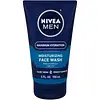What's inside
What's inside
 Key Ingredients
Key Ingredients

No key ingredients
 Benefits
Benefits

 Concerns
Concerns

 Ingredients Side-by-side
Ingredients Side-by-side

Water
Skin ConditioningCocamidopropyl Betaine
CleansingSodium Myreth Sulfate
CleansingDecyl Glucoside
CleansingGlycerin
HumectantPanthenol
Skin ConditioningAloe Barbadensis Leaf Juice
Skin ConditioningMenthol
MaskingAlcohol Denat.
AntimicrobialAcrylates/C10-30 Alkyl Acrylate Crosspolymer
Emulsion StabilisingPhenoxyethanol
PreservativePEG-90 Glyceryl Isostearate
CleansingPEG-40 Hydrogenated Castor Oil
EmulsifyingParfum
MaskingPolyquaternium-10
Laureth-2
CleansingBenzophenone-4
UV AbsorberSodium Hydroxide
BufferingMethylparaben
PreservativeEthylparaben
PreservativeBlue 1 Lake
Cosmetic ColorantWater, Cocamidopropyl Betaine, Sodium Myreth Sulfate, Decyl Glucoside, Glycerin, Panthenol, Aloe Barbadensis Leaf Juice, Menthol, Alcohol Denat., Acrylates/C10-30 Alkyl Acrylate Crosspolymer, Phenoxyethanol, PEG-90 Glyceryl Isostearate, PEG-40 Hydrogenated Castor Oil, Parfum, Polyquaternium-10, Laureth-2, Benzophenone-4, Sodium Hydroxide, Methylparaben, Ethylparaben, Blue 1 Lake
Water
Skin ConditioningGlycerin
HumectantSodium Laureth Sulfate
CleansingCocamidopropyl Betaine
CleansingAcrylates Copolymer
Sodium Lauroyl Isethionate
CleansingStearic Acid
CleansingPalmitic Acid
EmollientParfum
MaskingSodium Chloride
MaskingSodium Benzoate
MaskingCitric Acid
BufferingTetrasodium EDTA
Phenoxyethanol
PreservativePPG-9
Skin ConditioningIodopropynyl Butylcarbamate
PreservativeAlpha-Isomethyl Ionone
PerfumingBenzyl Salicylate
PerfumingLimonene
PerfumingLinalool
PerfumingCI 19140
Cosmetic ColorantCI 42090
Cosmetic ColorantCI 17200
Cosmetic ColorantWater, Glycerin, Sodium Laureth Sulfate, Cocamidopropyl Betaine, Acrylates Copolymer, Sodium Lauroyl Isethionate, Stearic Acid, Palmitic Acid, Parfum, Sodium Chloride, Sodium Benzoate, Citric Acid, Tetrasodium EDTA, Phenoxyethanol, PPG-9, Iodopropynyl Butylcarbamate, Alpha-Isomethyl Ionone, Benzyl Salicylate, Limonene, Linalool, CI 19140, CI 42090, CI 17200
Ingredients Explained
These ingredients are found in both products.
Ingredients higher up in an ingredient list are typically present in a larger amount.
Cocamidopropyl Betaine is a fatty acid created by mixing similar compounds in coconut oil and dimethylaminopropylamine, a compound with two amino groups.
This ingredient is a surfactant and cleanser. It helps gather the dirt, pollutants, and other impurities in your skin to be washed away. It also helps thicken a product and make the texture more creamy.
Being created from coconut oil means Cocamidopropyl Betaine is hydrating for the skin.
While Cocamidopropyl Betaine was believed to be an allergen, a study from 2012 disproved this. It found two compounds in unpure Cocamidopropyl Betaine to be the irritants: aminoamide and 3-dimethylaminopropylamine. High-grade and pure Cocamidopropyl Betaine did not induce allergic reactions during this study.
Learn more about Cocamidopropyl BetaineGlycerin is already naturally found in your skin. It helps moisturize and protect your skin.
A study from 2016 found glycerin to be more effective as a humectant than AHAs and hyaluronic acid.
As a humectant, it helps the skin stay hydrated by pulling moisture to your skin. The low molecular weight of glycerin allows it to pull moisture into the deeper layers of your skin.
Hydrated skin improves your skin barrier; Your skin barrier helps protect against irritants and bacteria.
Glycerin has also been found to have antimicrobial and antiviral properties. Due to these properties, glycerin is often used in wound and burn treatments.
In cosmetics, glycerin is usually derived from plants such as soybean or palm. However, it can also be sourced from animals, such as tallow or animal fat.
This ingredient is organic, colorless, odorless, and non-toxic.
Glycerin is the name for this ingredient in American English. British English uses Glycerol/Glycerine.
Learn more about GlycerinParfum is a catch-all term for an ingredient or more that is used to give a scent to products.
Also called "fragrance", this ingredient can be a blend of hundreds of chemicals or plant oils. This means every product with "fragrance" or "parfum" in the ingredients list is a different mixture.
For instance, Habanolide is a proprietary trade name for a specific aroma chemical. When used as a fragrance ingredient in cosmetics, most aroma chemicals fall under the broad labeling category of “FRAGRANCE” or “PARFUM” according to EU and US regulations.
The term 'parfum' or 'fragrance' is not regulated in many countries. In many cases, it is up to the brand to define this term.
For instance, many brands choose to label themselves as "fragrance-free" because they are not using synthetic fragrances. However, their products may still contain ingredients such as essential oils that are considered a fragrance by INCI standards.
One example is Calendula flower extract. Calendula is an essential oil that still imparts a scent or 'fragrance'.
Depending on the blend, the ingredients in the mixture can cause allergies and sensitivities on the skin. Some ingredients that are known EU allergens include linalool and citronellol.
Parfum can also be used to mask or cover an unpleasant scent.
The bottom line is: not all fragrances/parfum/ingredients are created equally. If you are worried about fragrances, we recommend taking a closer look at an ingredient. And of course, we always recommend speaking with a professional.
Learn more about ParfumPhenoxyethanol is a preservative that has germicide, antimicrobial, and aromatic properties. Studies show that phenoxyethanol can prevent microbial growth. By itself, it has a scent that is similar to that of a rose.
It's often used in formulations along with Caprylyl Glycol to preserve the shelf life of products.
Water. It's the most common cosmetic ingredient of all. You'll usually see it at the top of ingredient lists, meaning that it makes up the largest part of the product.
So why is it so popular? Water most often acts as a solvent - this means that it helps dissolve other ingredients into the formulation.
You'll also recognize water as that liquid we all need to stay alive. If you see this, drink a glass of water. Stay hydrated!
Learn more about Water